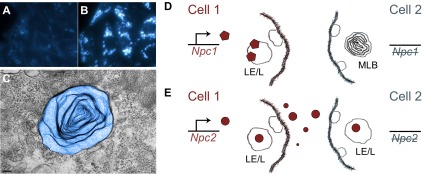Fig. 1.

Comparison of cell-autonomous and non-cell-autonomous rescue of the lipid-storage defect in NPC disease. (A,B) The severe intracellular accumulation of unesterified cholesterol caused by the loss of NPC1 function is demonstrated here by comparing filipin-stained (blue) (A) wild-type K1 CHO cells and (B) Npc1 mutant M12 CHO cells. Abundant multivesicular structures and multilamellar bodies (MLBs) accompany the storage disorder. (C) A transmission electron microscope image of a single elaborate MLB (pseudo color) is shown. (D,E) Although loss of either NPC1 or NPC2 function elicits a nearly identical cellular phenotype in NPC, (D) NPC1, a non-secreted late endosomal/lysosomal (LE/L) membrane protein, acts cell-autonomously, whereas (E) NPC2, a secreted cholesterol-binding protein, acts non-cell-autonomously. Thereby, production of NPC1 in a cell (D; cell 1) cannot correct the storage defect, depicted here by an MLB, in a neighboring NPC1-deficient cell (D; cell 2). By contrast, an NPC2-producing cell (E; cell 1) can rescue the storage defect in an NPC2-deficient cell, indicated by the absence of an MLB (E; cell 2).
